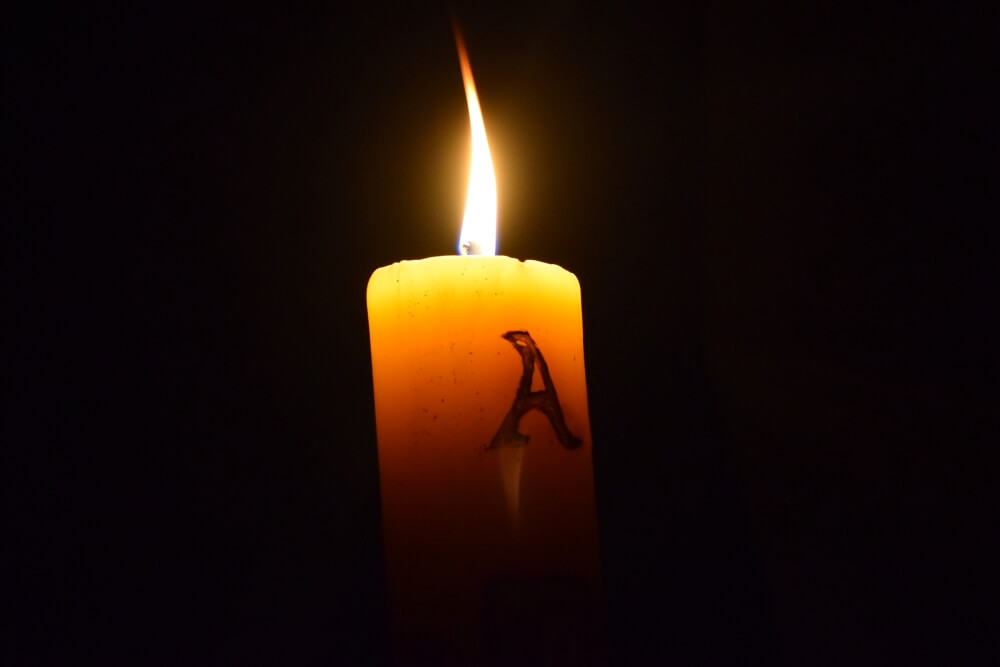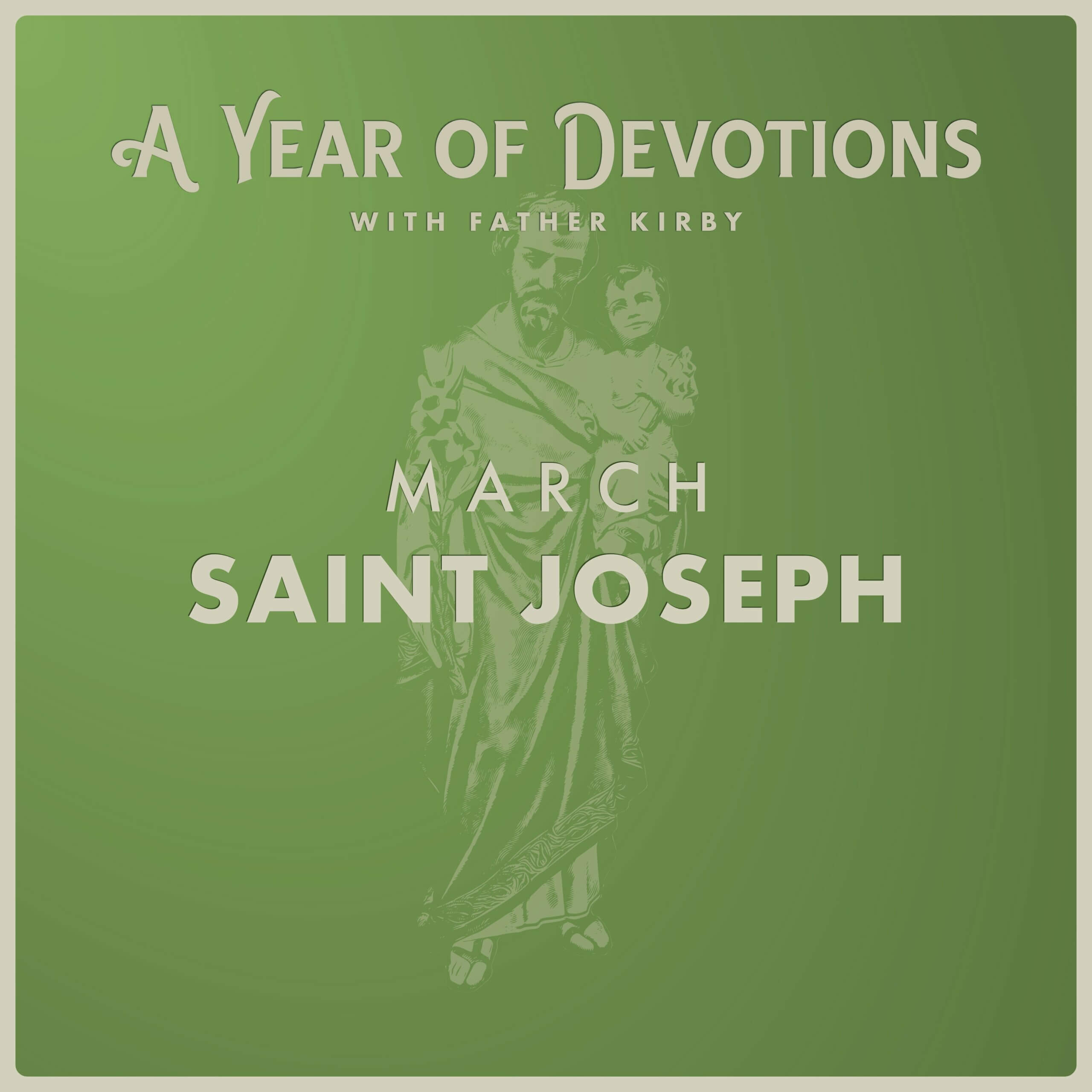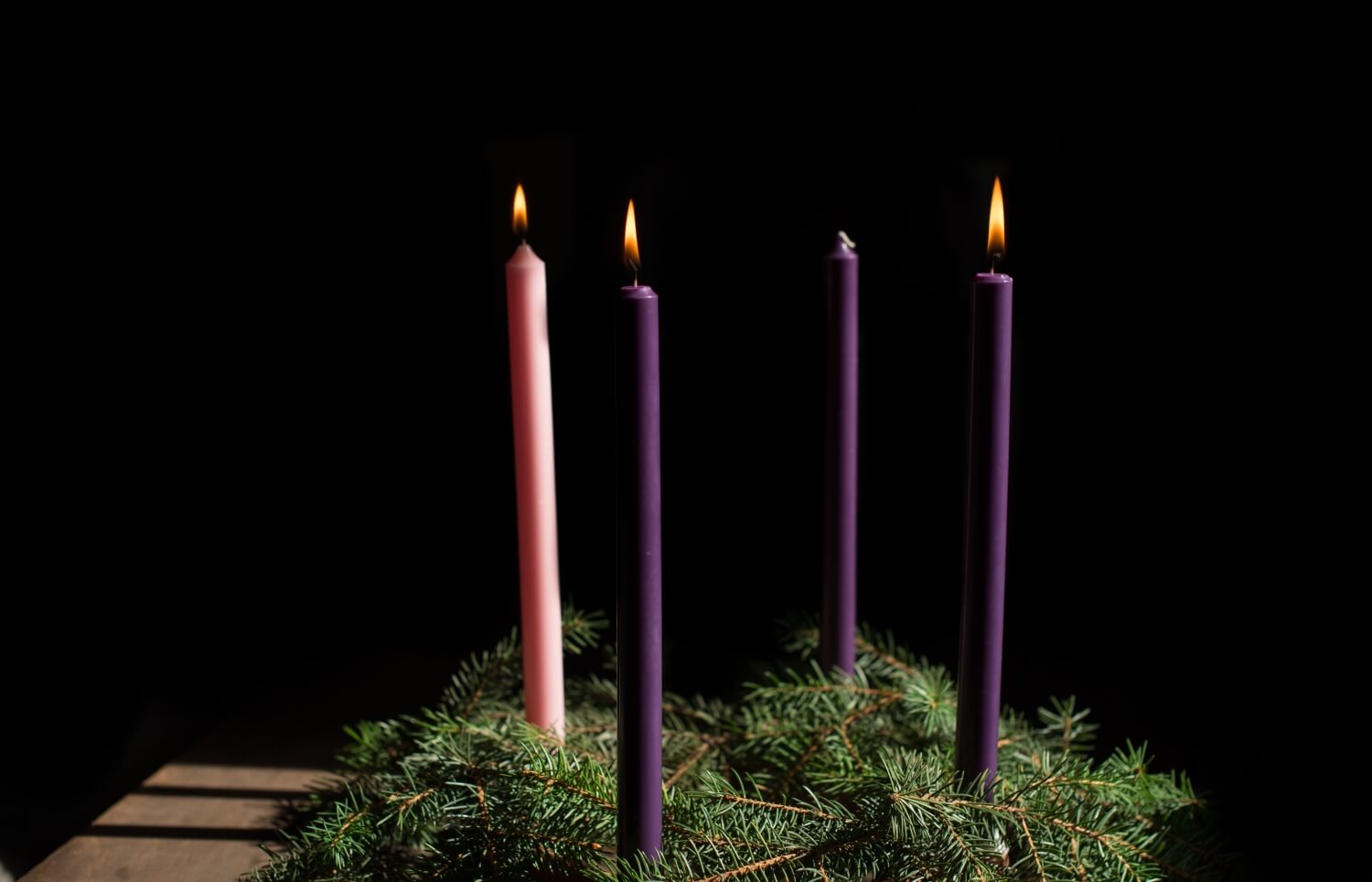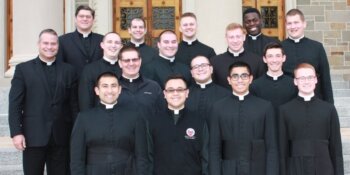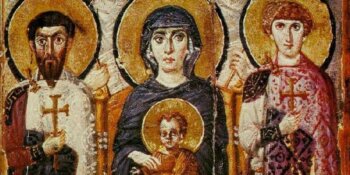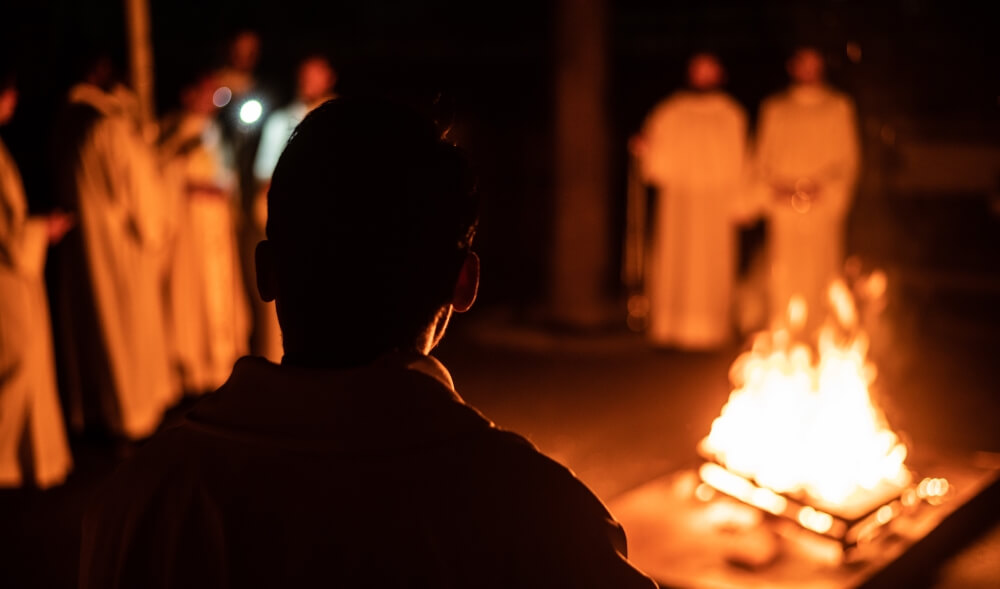
There is something mysterious about fire. It can sustain life at the glowing hearth or it can destroy it in a devouring conflagration. It commands immediate respect.
Is it any wonder, then, that fire has been linked to a greater force than our own since the fall of man? From time immemorial the human race has utilized this burning element in ceremonies of divine worship.
Yet Christ in His Resurrection makes all things new, and fire has been given a higher function at the solemn mother of all holy vigils, that night of radiant splendor, the Easter Vigil of Holy Saturday.
In the aftermath of the Good Friday liturgy, which is focused so intently on the sufferings and death of Our Lord, Holy Saturday is a day of solemn mourning. Images of the agony of the Sacrificial Lamb, still fresh in our minds, are now replaced by reminders of His burial place, the hallowed tomb and the sealed stone. The Savior has paid the price for our redemption, but at an incalculable cost!
However, this day is also one of anticipation. We eagerly await the joy of His Resurrection and as Saturday evening draws to a close, the Paschal Vigil begins—and it begins with fire.
The Ancient Use of Fire Across the World
Not long after our first parents were driven from the Garden of Eden, Sacred Scripture tells of Cain and Abel making offerings to the Almighty. If God accepted them, the goods were consumed with fire. Therefore, burning was most often the means by which sacrifice was made to the Creator, and the Old Testament is full of such examples.
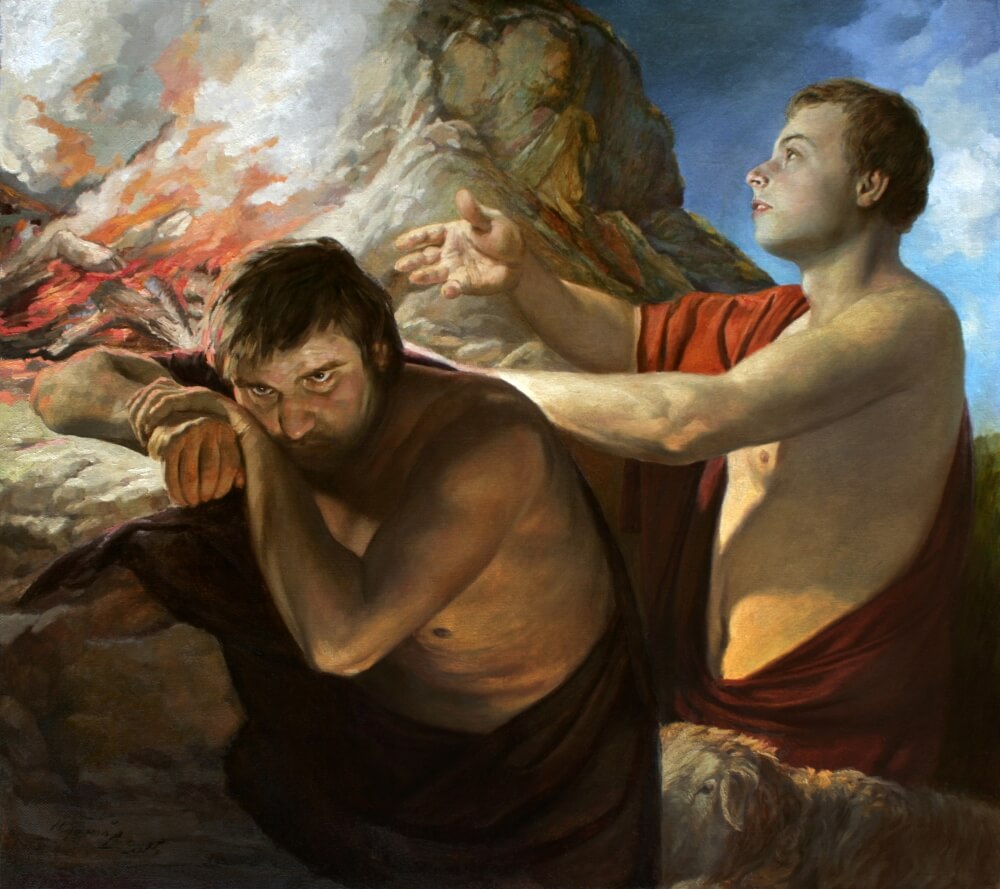
Yet this was not a practice exclusive to God’s Chosen People. Both the Greeks and the Romans record fire worship in honor of their gods, especially in the case of the Vestal Virgins who tended the sacred fires of the hearth. Even the myth of Prometheus has strong ties to the supernatural, for it identifies the stolen flame brought down to the human race as property of the Olympian gods and not of man’s creation. Hinduism also places a good deal of emphasis on fire’s inextricable relationship with their deities. Several North American Indian tribes have integrated rituals around the lighting of bonfires, as have the Mayans and Aztecs of Central and South America.
In fact, it may be harder to find a civilization that didn’t use fire as a way to honor the divine. And sure enough, fire found a place in the most important Catholic feast of the liturgical year.
We have St. Patrick to thank for that.
St. Patrick and the First Paschal Fire
The ancient Celts held an annual festival after the spring equinox honoring Beltane, god of the sun. Every flame in the Gaelic kingdoms was extinguished and at twilight, the high king and his druids ignited a new fire from which all other lights were lit.
St. Patrick, in his missionary quest to evangelize Ireland, recognized that the great fire was a means by which he could win over the hearts and minds of the Irish people. Instead of abolishing the old custom, the bishop of the Emerald Isle showed that it could be repurposed in the service of the Good News. He used the Beltane bonfire ceremonies as a blueprint for his celebration of the Easter Vigil liturgy.
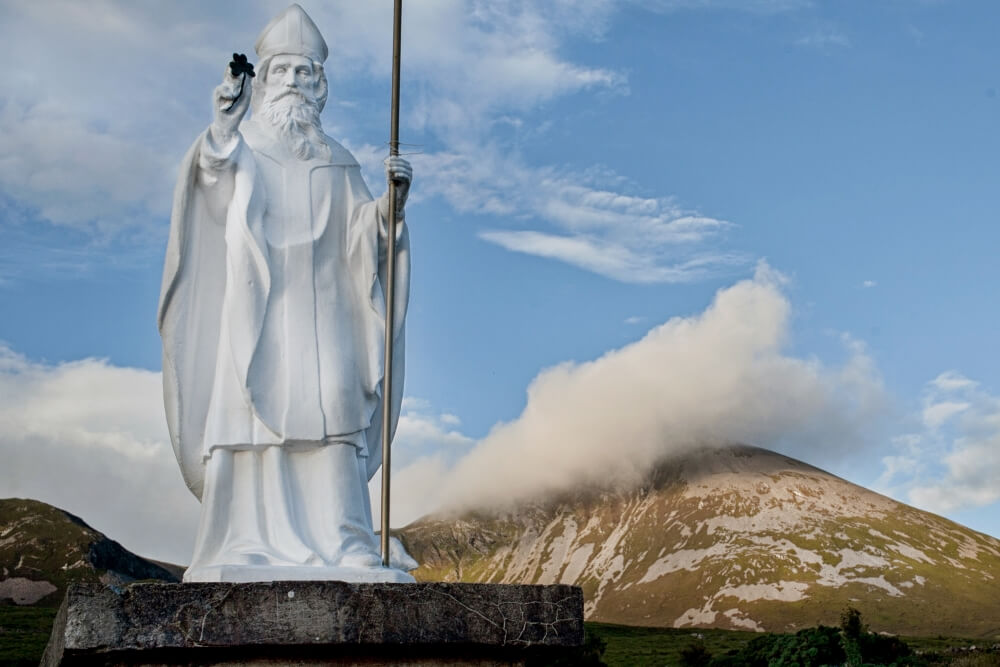
Photo by Tom Szustek/CC BY-SA 4.0
To this day, we get to see the Paschal fire kindled as the holy ceremonies begin. Flint and steel spark the fires so that the new light comes to be without the help of any other flame, and the light is then spread to the faithful as the service progresses. Thus, the initial ceremony of Easter bears the fingerprints of a great saint upon it, and illustrates just how timeless the Catholic liturgy is, considering that we still closely follow the ritual of a holy man who worked for God over a thousand years ago.
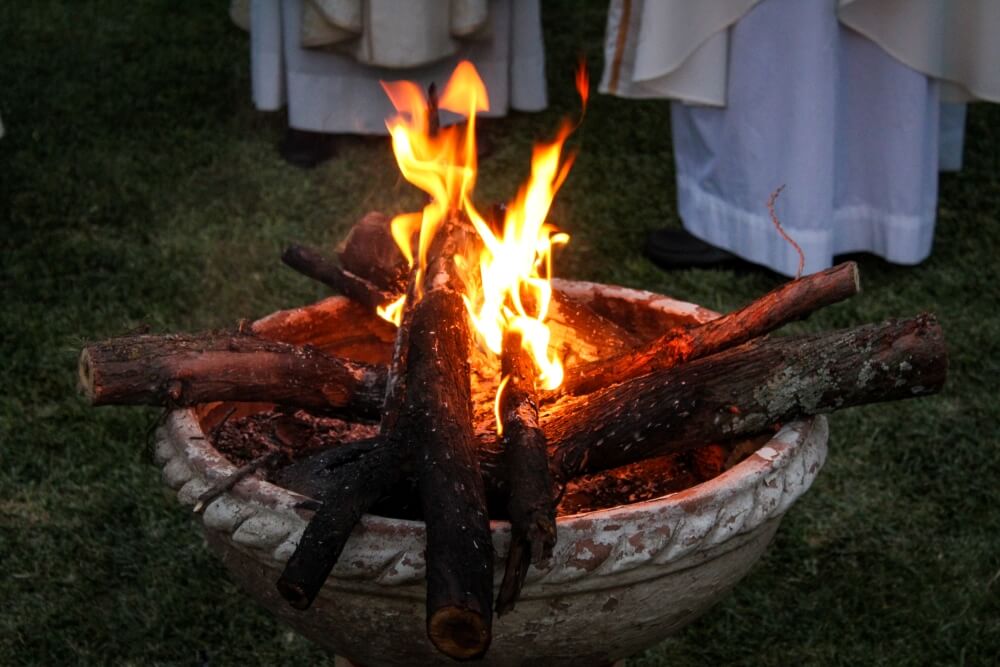
St. Thomas Aquinas said that grace builds upon nature, so it was not only natural but fitting for the Church to integrate the ancient fiery ceremonies into her own liturgies.
The Symbolism of the Paschal Candle
The vigil continues once the holy fire is lit. After a brief prayer, the new Easter fire is sprinkled with holy water. Red hot coals are drawn out from the crackling blaze and placed in the thurible. Incense is scattered over them and the dancing flares are blessed thrice with the fragrant smoking clouds that billow forth.
A tall candle, better resembling a waxen column, is furnished and brought before the bonfire. The celebrants trace or carve symbols into it while revered words are spoken over it. Emblazoned in the wax is a cross with the current year of Our Lord surrounding it as well as the Greek letters Alpha and Omega. Five grains of incense are also fixed in the towering beacon.
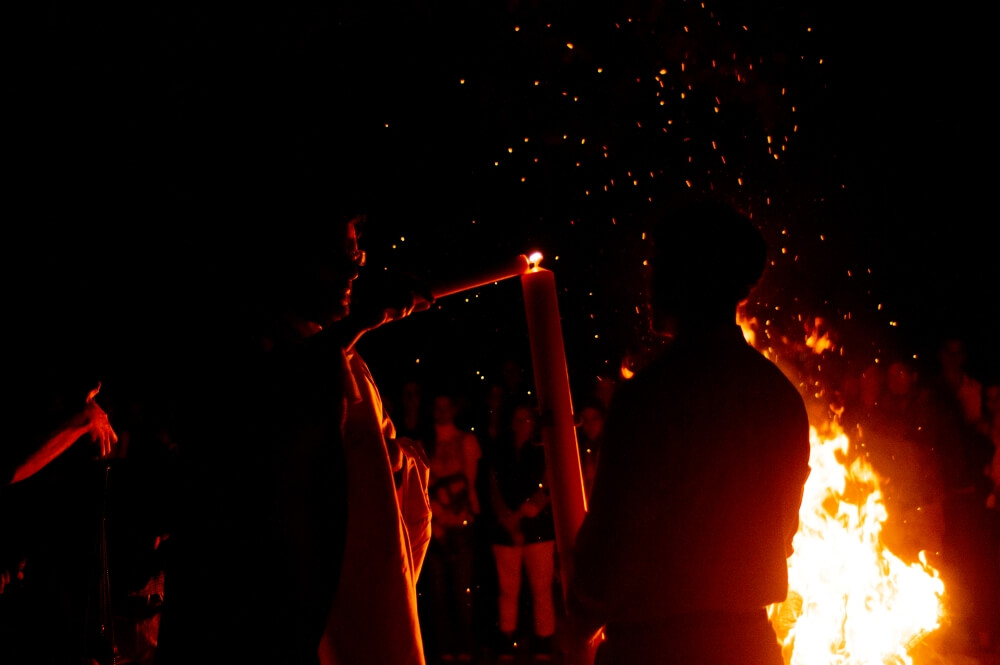
As this candle is lit from the sacred fire, it becomes a representation of the risen Christ. The symbolism here is staggering, for not only does the candle function as a figure of God Himself, but it also serves as a key to the history of the Church and a guide to the sacred liturgy of this most blessed feast.
The cross is the emblem of the Passion and death of Jesus, His public act of love for us; it also demonstrates that even death holds no power over God made Man, the Source of all life Who has overcome death. The dating of the year is a testimony to the kingship of Christ; death no longer holds sway, so all time is under His rule. Indeed, it is a reminder that He is here with us now. The Resurrection speaks volumes about God as the Ultimate Ruler.
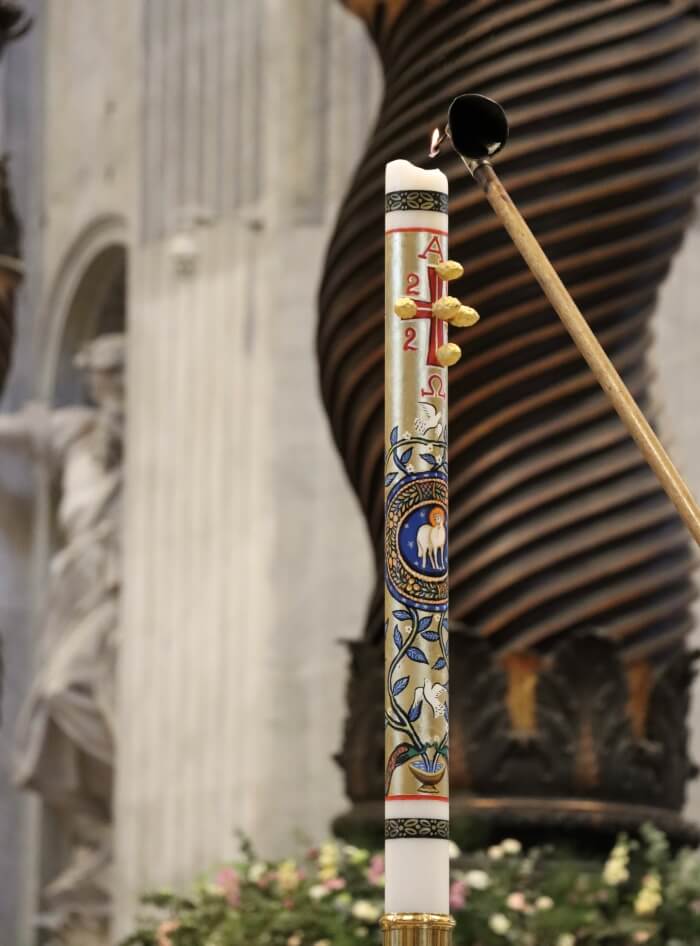
The incense grains stand for the five major Wounds Christ endured on the Cross: the nail wounds in His hands and feet and the lance wound in His side. Finally, the letters Alpha and Omega herald Our Redeemer as the beginning and end of all creation. Just as the Light of the World conquered the darkness of evil and everlasting death, the wax pillar aflame dispels the shadows of the night. Through this candle, the grace of heaven illuminates our minds, warms our hearts, and protects our souls.
The Great Service of Light
What follows is known as the first part of the sacrum lucernarium (the great service of light) and is one of the oldest Easter customs in the Church.
Bishop Eusebius, who preserved much of early Christian history, recorded the celebrations in the reign of the Roman emperor Constantine, who “transformed the night of the sacred vigil into the brilliancy of day, by lighting throughout the city pillars of wax, while burning lamps illuminated every part, so that the mystic vigil was rendered brighter than the brightest daylight.”
The priest and deacons pass through the church doors into the totally darkened church, holding the sacred light ever higher as they chant “Lumen Christi” (“the Light of Christ”) three times. The congregation follows and just as goodness is diffused without diminishing, the light of the Paschal candle is shared and spread to the smaller tapers of the faithful and burns ever brighter.
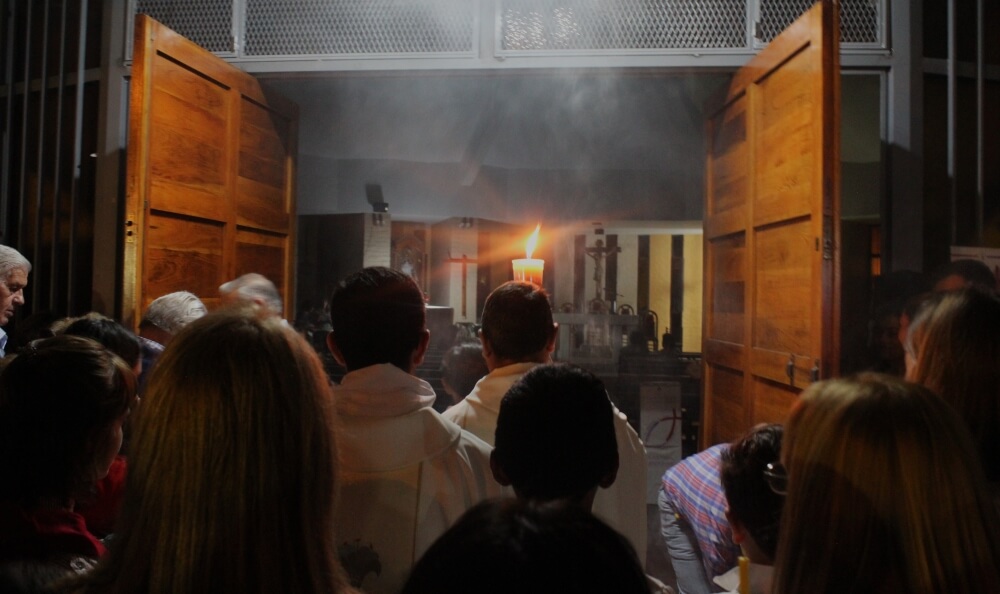
Then the Exultet is chanted. It is a song of jubilation recounting the most joyous occasion of new life. It is an invitation to honor our Risen Lord in the light of faith. It is a poem of wonder brimming over with fiery language. Scarcely a stanza is sung that does not hold some allusion to the warmth of the sun, burning love, liveliness of faith, raging pillars of fire, or the shining stars.
The Marvelous Story of Salvation
The Lessons from the Prophecies then succeed the Exultet. Here, too, the candle is an active participant in the ceremonies, functioning as a light for the ministers to read by and reaching back in time to retell important chapters from salvation history. Each of the chosen Lessons contains some aspect that the Paschal light also possesses, highlighting a continued connection between us as the audience and the workings of God, personified in the waxen tower.
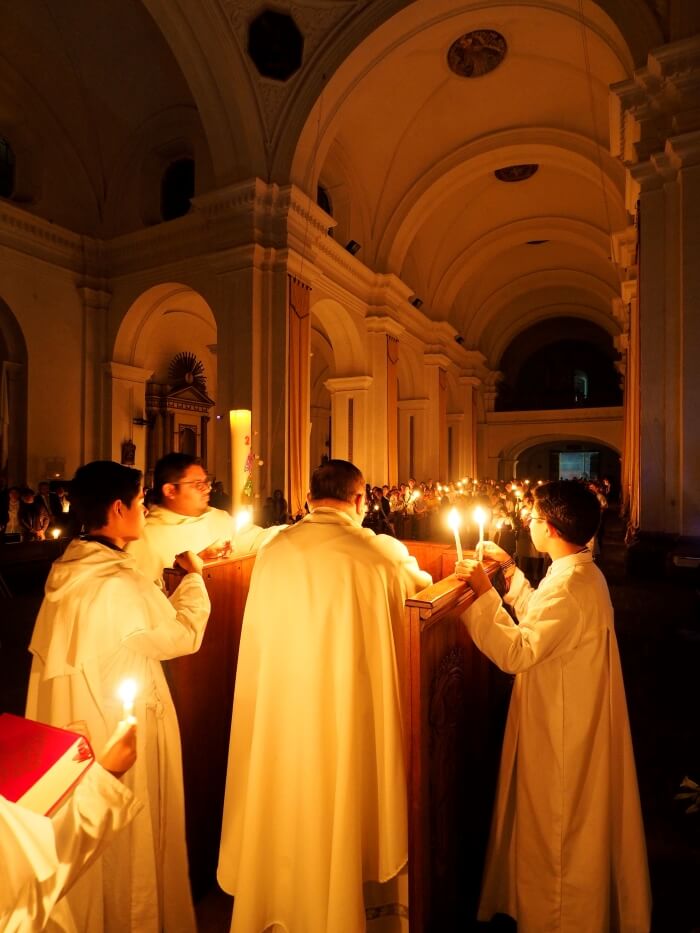
In years past it was customary to review twelve biblical accounts that foretold our redemption. Now the numbers differ according to rite, form, and diocese. Some feature all twelve, others seven or four, but none less than two. While not every prophecy features fire directly, most do, as in the first chapter of Genesis when God said: “Let there be light.”
The test of Abraham may also be featured, since his son Isaac, as the sacrificial victim, prefigured the sacrifice of Jesus Christ. This account ends with Abraham offering a ram on an altar as a burnt holocaust to God.
The tale of the Exodus underscores the pillar of flame that guarded the passage of the Israelites in their flight from Egypt through the Red Sea. The narrative of Isaiah also mentions this same episode. Elijah’s ascent into heaven in a fiery chariot may be sung. The book of Daniel recalls the fiery furnace and the mercy of God preserving His faithful from harm. In the 1962 Roman Missal of the Extraordinary Form, or Traditional Latin Mass, the lessons conclude with the book of Deuteronomy, where Moses writes down the law of God before he dies and teaches the leaders of each tribe a new canticle. Here, fire is not explicitly mentioned, but it can be inferred that the Prophet is handing on the torch of faith to the Hebrews and its conclusion is accompanied by a song of joy.
These are the stories of the wondrous ways in which the Creator orchestrated our redemption across the ages—and the marvelous Paschal candle is our link to it all.
The Fire of the Candle and the Waters of Baptism
The narratives from the Old Testament now over, the first part of the Litany of Saints is performed before the Paschal candle is taken to the baptismal font to assist with the blessing of the baptismal waters. With Christ conquering the grave, the Paschal vigil places particular importance on Baptism, which brings a new life of grace. Through the saving waters we die to sin to rise in a life renewed in God.
Just as the pillar of fire protected the Israelites, allowing their escape to freedom through the parted Red Sea, the Paschal flame stands guard as the holy waters are symbolically parted: the priest blows over the water’s surface, foreshadowing the redemptive qualities of the Sacrament of Baptism.
This holy ritual emphasizes that our salvation comes through Christ, represented by the Paschal flame; and that it is through the sacraments of Christ’s Church that we receive and are nourished in the life of grace. Here, then, it is customary for any new converts, or catechumens, in the parish to receive the Sacrament of Baptism, their blessed rebirth in Christ, using the freshly consecrated waters from the font. Then, the entire communion of souls present renew their baptismal promises in unison (whether or not any baptisms take place).
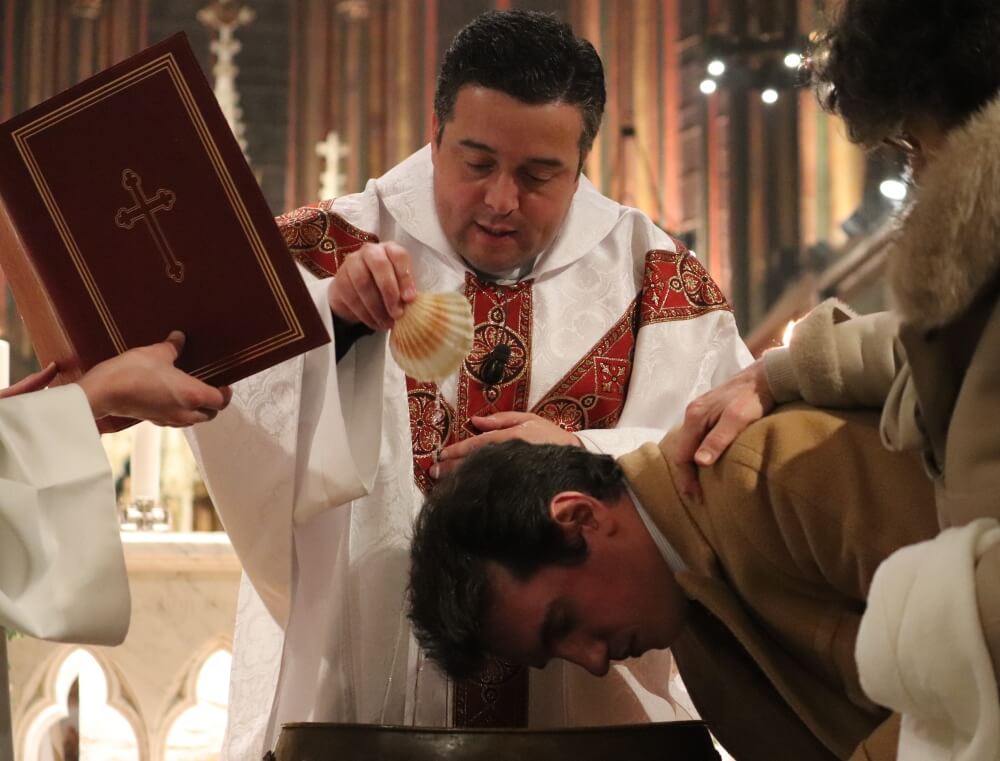
The final function of the Easter flame at the regenerative waters is to serve as a reminder that the Word Made Flesh will come again to judge the living and the dead and the world by fire. It is interesting to note that after Ascension Thursday, once the candle is removed from the sanctuary, it is relegated to the baptistry for the remainder of the liturgical year, only being relit when a new soul is to be received into the fold through Baptism. Again, this fire remains as a symbol of rejuvenation, new life, and the growth of the children of God.
From the Symbolism of the Candle to the Reality of the Eucharist
For the rest of the Vigil proceedings, the Easter torch is moved from the center of the sanctuary to the Gospel side of the altar—the side from which the priest proclaims the Good News.
Why?
While the shining light is a near perfect symbol for the Risen Christ, it remains as a beacon, something that we can only observe at some distance. In order for the Light of lights to become closer, to become one with us, Our Lord must take the form of nourishment, the Bread of Life.
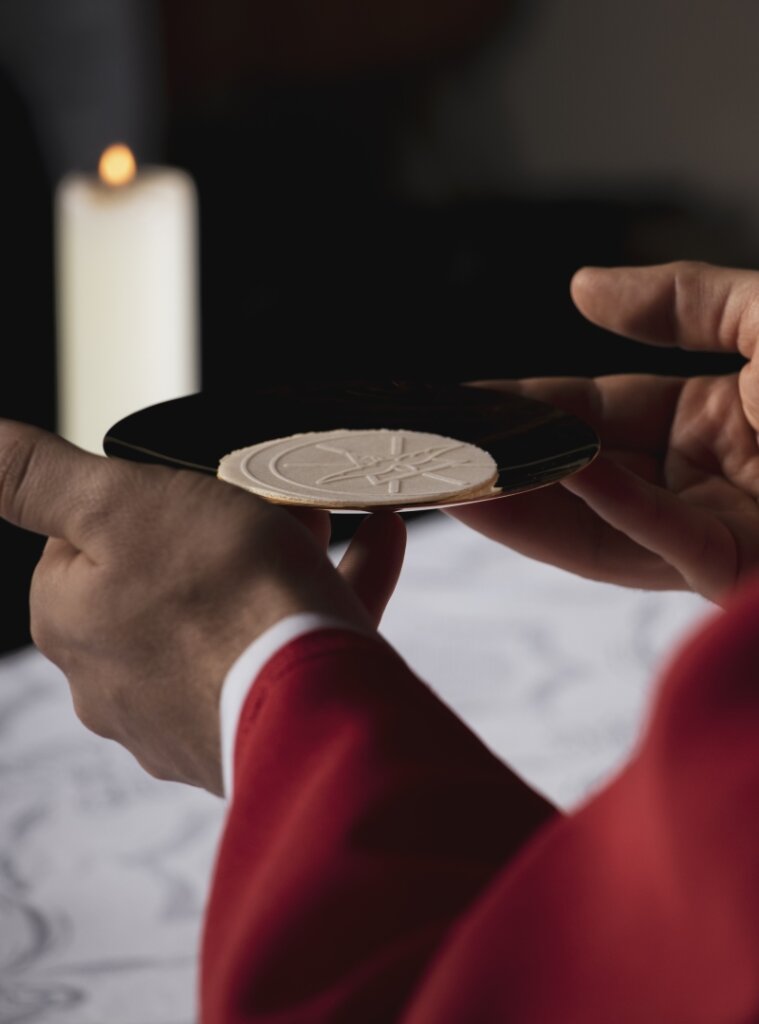
No longer will the Son of God remain a symbol. He comes down to us in person, in the Real Presence of the Eucharist. The candle steps aside so that Our Redeemer may come to us directly. No blazing inferno follows His majesty, no fierce fireworks or flaring cloud of smoke. Fire serves to make His presence known to us until we are ready to receive Him into our very souls in peace. Our Savior comes to us in silence, in the stillness of His Heart conversing with ours.
“…and the darkness did not comprehend it.”
The Paschal flame is a conglomeration of history and grace. It illuminates for us our path to the Most Blessed Trinity. Through the fiery tales of the Old Testament and the attempts of pagans to venerate the divine, Our Savior renews His promise to us of a new life with Him in heaven through the simple, yet profound medium of a lighted candle.
As St. John wrote in the beginning of his Gospel: “In him was life and the life was the light of man. And the light shineth in the darkness, and the darkness did not comprehend it.”
Let us therefore rejoice in this season of renewal, for now, as fervently as the Easter fire enkindled, we can truly say: “Be glad, for the Lord is truly risen, Hallelujah!”
